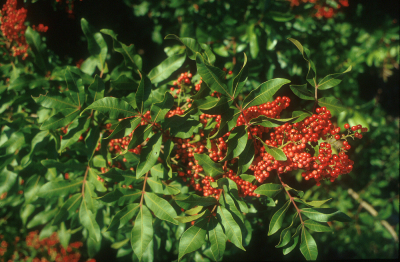Brazilian Peppertree Facts

- Brazilian peppertree, Shinus terebinthifolia, is a relative of poison ivy. Brazilian peppertree is one of the most damaging invasive weeds of agricultural and natural areas of Florida, Hawaii, and Texas.
- Brazilian peppertree is native to Brazil, and introduced into Florida as an ornamental in the late 1800s.
- Traditional control methods have failed to keep up with the spread of this invasive weed.
- Biological control presents an environmentally-safe and cost-effective control method for invasive populations of this weed.
- USDA-ARS and University of Florida/IFAS research discovered biological controls specific to this weed that will be safe and effective. Brazilian peppertree infests over 700,000 acres in Florida, including many sensitive habitats such as mangroves and sawgrass marshes in the Everglades.
- Brazilian peppertree causes allergic reactions and respiratory illness in sensitive people due to volatiles released by the leaves, flowers, and fruits. Ingestion of the leaves and fruits can have narcotic and toxic effects in grazing animals and birds.
- Brazilian peppertree negatively impacts rare, native species such as clustervine, beach star, and the gopher tortoise.
- Chemical and mechanical control measures are costly and maintenance programs are required to prevent regrowth. Despite the expenditure of millions of dollars, traditional methods have been unable to stem the spread of this weed. While these control efforts continue, federal, state, and local land managers expend millions annually while waiting for better control options.
- Between 2010 and 2011, the Florida Fish and Wildlife Conservation Commission (FWC) spent $7 million in herbicidal controls. In 2011, the South Florida Water Management District spent $1.7 million to control Brazilian peppertree. These budgets would have been larger if resources permitted.
